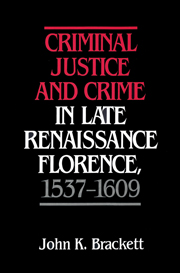Book contents
- Frontmatter
- Contents
- Acknowledgments
- Introduction
- 1 The bureaucratic structure of the Otto: the personnel and their functions
- 2 Financing the Otto
- 3 The Otto as police: organization and function
- 4 Criminal procedure before the Otto: from discovery to sentencing
- 5 The Otto and its role in the centralization of criminal justice in the Florentine state
- 6 Crime and criminals
- Conclusion
- Appendix 1 Names of other officers of the Otto di Guardia e Balìa, 1537–1609, as we have them
- Appendix 2 Budget totals by year
- Appendix 3 Comparison of detailed average expenditures for budgets, 1537–1547 and 1598–1609
- Appendix 4 Occupation key
- Bibliography
- Index
Introduction
Published online by Cambridge University Press: 05 September 2009
- Frontmatter
- Contents
- Acknowledgments
- Introduction
- 1 The bureaucratic structure of the Otto: the personnel and their functions
- 2 Financing the Otto
- 3 The Otto as police: organization and function
- 4 Criminal procedure before the Otto: from discovery to sentencing
- 5 The Otto and its role in the centralization of criminal justice in the Florentine state
- 6 Crime and criminals
- Conclusion
- Appendix 1 Names of other officers of the Otto di Guardia e Balìa, 1537–1609, as we have them
- Appendix 2 Budget totals by year
- Appendix 3 Comparison of detailed average expenditures for budgets, 1537–1547 and 1598–1609
- Appendix 4 Occupation key
- Bibliography
- Index
Summary
Among the striking features of contemporary European society, none is more important than the modern centralized state. To understand how centralization came about, one must examine the mechanisms of state power – the bureaucracies, which serve as conduits for the transfer of power from the various strata of society to the executive level. This redirection of power is accomplished through the issuance and more or less effective enforcement of regulations that attempt to order relations between individuals, various collectivities, and the particular bureaucrats who head the institutions of government. Bureaucracies are thus contact points in a process of contest and compromise between competing sets of private and public interests.
Italy made some early contributions to the formation of the state during the Renaissance, when lay bureaucracies first appeared. Florence is particularly noteworthy because of the richness of its archives and the extensive literature devoted to its history. The rise of the sixteenth-century Tuscan state illustrates the transformation of a communal, traditional polity with a republican form of government into an aristocratic absolutist state. Until recently, few non-Italian scholars were interested in granducal Tuscany because they assumed that significant political development in Florence had ceased with the fall of the republic in 1530. Eric Cochrane attempted to stimulate interest in this period with his book, Florence in the Forgotten Centuries (1973).
- Type
- Chapter
- Information
- Publisher: Cambridge University PressPrint publication year: 1992



